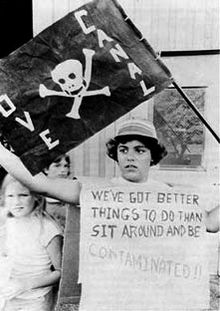Love Canal
Love Canal is the name of a neighborhood in Niagara Falls in the US state of New York . “Love Canal” also describes one of the first major toxic waste scandals that fueled the awakening environmental awareness of the 1970s after decades of careless handling of chemical waste.
prehistory
Creation of the duct section
The name is derived from the entrepreneur William T. Love , who wanted to build a model town with a planned 600,000 inhabitants in the early 1890s. A canal should enable shipping between Lake Erie and Lake Ontario , the gradient of the canal should provide hydropower for the planned settlement of many industrial plants. Love obtained funding commitments from banks in the group around John Pierpont Morgan and signed a remarkable contract with the state of New York, which not only allowed him to procure the land for the planned city, but also to draw as much water from the Niagara River as he did wanted, right up to Niagara Falls falling dry .
The project was initially delayed by the Depression of the 1890s and finally fell through with Nikola Tesla's almost simultaneous development of AC technology . This made it possible to transport alternating current from hydropower transformed to a higher voltage level over long distances and use it decentrally. An economic basis for Love's project of industrial centralization around a huge mill canal was no longer given and the work was stopped after a canal trench about 1.5 km long and 20 m wide had been dug.
Love's project company was liquidated, with the last pieces of land being sold in the 1920s.
1920–1942: Use of the canal trench as a garbage dump
The canal trench and surrounding land was auctioned off in 1920 and acquired by the city of Niagara Falls, which made the canal available as a landfill for its thriving chemical industry. The United States Army also used the landfill to bury waste from chemical warfare experiments.
1942–1952: Hooker intensified its use as a toxic waste dump
From 1942 onwards, the Hooker Chemical and Plastics Corporation , which was bought by Occidental Petroleum in 1968 , significantly expanded its toxic waste dumping operations. She acquired the site in 1947 and stored around 14,000 cubic meters of toxic waste in the canal trench by 1952 . Then the capacity limit was reached and Hooker applied an insulating layer of clay and brought the sewer to ambient level. The area was closed for further garbage dumping.
Settlement of the area
Purchase by the school authorities and school building
As Niagara Falls grew rapidly due to the " baby boom ", the school board was very interested in cheap building land for an elementary school and entered into negotiations with Hooker Chemical. They initially refused to sell and then tried to have the exclusive use of the area as a parking lot stipulated. Hooker Chemicals eventually sold the land for the symbolic price of one US dollar after the school board threatened expropriation - but not without performing eight test wells in front of the school board, two of which actually encountered chemicals. In the sales agreement a has Disclaimer for Hooker explicitly stated and warned of problems in development.
The location of the planned school had to be moved during the construction work because chemical-filled pits were discovered at the original location. The new location was directly above the former toxic waste dump. During the excavation work, the clay layer that Hooker had applied was broken through.
Construction of a residential area
In 1957, the site for building with low-cost apartments and single-family homes was opened . The development was largely completed by the end of the 1960s. The new owners were not informed about the toxic waste dump under their homes.
Resident initiative and resettlement
The residents soon began to complain. Strange smells appeared, chemical substances leaked to the surface of the earth in the gardens. Children in elementary school seemed to be sick all the time. Statistical evaluations showed an excessive number of cancer cases and malformations in the affected area.
Starting in 1978, a local residents' initiative, led by Lois Gibbs , began calling the Love Canal Homeowner's Association to investigate the problems. The dangers that had hitherto been hidden became known. The residents' initiative tried to prove the responsibility of Hooker Chemical. She not only had to fight against Occidental Petroleum, the parent company, but also against all authorities involved. However, it was possible to draw the attention of the press and television to the scandal, so that President Jimmy Carter declared the area a disaster area on August 7, 1978. Those affected were only relocated from 1980 onwards. The primary school and a large part of the residential areas on and directly next to the canal ditch were demolished. However, some older residents decided to stay in their homes.
The successful press work of the residents' initiative became a model for environmental groups all over the western world.
Love Canal was one of the triggers for the passing of the Comprehensive Environmental Response, Compensation, and Liability Act , which enabled the creation of the Superfund program for the remediation of contaminated sites.
Mentions in film and literature
In the feature film Tootsie with Dustin Hoffman , the events are briefly recalled in a subordinate clause.
In Erin Brockovich with Julia Roberts , her boss Ed Masry also speaks about the legal aftermath in connection with the class action and its success at the meeting of those affected.
The environmental scandal also plays in the 2004 novel, Niagara by Joyce Carol Oates a role.
Web links
Individual evidence
- ^ Dan Fagin : Toms River: A Story of Science and Salvation . Bantam Books, New York 2014, ISBN 978-0-345-53861-1 . P. 125.
- ↑ Eric Zuesse: Love Canal: The truth seeps out. In: reason.com . February 1981, accessed August 7, 2018 .
Coordinates: 43 ° 5 ′ N , 78 ° 57 ′ W
